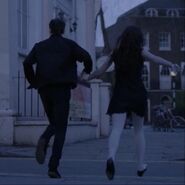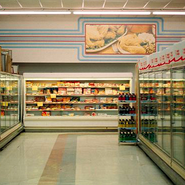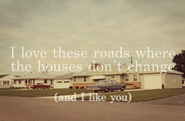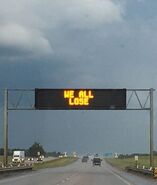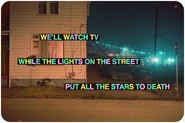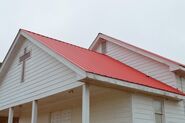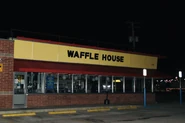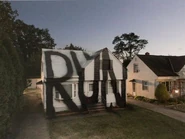Suburban Gothic is an aesthetic based around feelings of alienation and the uncanny, usually represented in being alone in suburban neighborhoods. Common motifs include coming-of-age, familial/generational trauma, facades, and the shallowness of capitalistic culture. The motifs and photographs are American-centric, with parodies and dark interpretations of the 1950s nuclear family and 1980s economic boom. Those characters and locations tend to have a dark secret, such as drug addiction or infidelity, to emphasize the darker nature of the restrictiveness of social norms.
Much of the modernization of this aesthetic has been defined by the director David Lynch (hence the term “Lynchian” used to describe much of Suburban Gothic’s attributes).
It’s important to note that while Lynch is a purveyor of Surrealism and the supernatural, not all of Suburban Gothic is surreal by nature. Some is even realistic, although still highly stylized.
While sharing similar traits with Southern Gothic and Midwest Gothic, there is no specific region or nation that appears prominently in suburban gothic. The aesthetic has its origins in literature, film, and television, but later gained a visual aesthetic and more examples through short bullet-pointed lists with the regional gothic trend on Tumblr in the mid-2010s. In this version, there is a heavy emphasis on the use of Liminal Space, supernatural beings, and tropes typically found in suburban culture, such as housewives and cheerleaders.
Visuals[]
- Animals that evoke the supernatural, such as black dogs or deer
- Beings/items that seem misplaced in the setting
- Convenience stores
- Drugs and people who appear to be addicted to them
- Empty diners
- Fog
- Ghosts, especially sheeted
- Graffiti
- Grocery stores
- Laundromats
- Lights that are an unusual color, such as red or blue
- Malls
- Playgrounds
- Roads and highways
- Run-down cars
- Street lamps
- Suburban neighborhoods at night
- Traumacore-style edits of depressing messages layered over images
- Technology from the 60s-80s, such as box TVs and telephones
Media[]
For more, see the TVTropes page.
Books[]
- White Noise by Don DeLillio
- Such a Quiet Place by Megan Miranda
- Comfort Me With Apples by Catherynne M. Valente
Movies[]
- American Beauty (1999)
- Beetlejuice (1988)
- Blue Velvet (1986)
- Carrie (1976)
- Edward Scissorhands (1990)
- Ghost World (2001)
- Gone Girl (2014)
- Heathers (1988)
- Jennifer's Body (2009)
- Mon Oncle (1958)
- Super Dark Times (2017)
- The Burbs (1989)
- The Nightmare on Elm Street (1984)
- The Stepford Wives (1975 & 2004)
- The Virgin Suicides (1999)
- Suburbia (1983)
- Tuff Turf (1985)
- Phantasm series (1979-2016)
Podcasts[]
- Welcome to Night Vale
TV Shows[]
- The Twilight Zone (specifically episodes centering around suburbia, such as "The Monsters are Due on Maple Street")
- The Addams Family (1964-1966)
- Kolchak: The Night Stalker (1974-1975)
- Twin Peaks (1990-1991)
- Picket Fences (1992-1996)
- Desperate Housewives (2004-2012)
- Pretty Little Liars (2010-2017)
- American Horror Story: Murder House (2011)
- Stranger Things (2016-)
- American Horror Story: Cult (2017)
- Riverdale (2017-2023)
- Creeped Out (2017-2019)
- Sharp Objects (2018)
- Dead to Me (2019-2022)
- Why Women Kill (2019-2021)
Music[]
There is no specific music genre, but due to the heavy influence of David Lynch on this aesthetic, ethereal wave, dream pop, and dark ambient have a heightened importance and influence. This seems to be done to contrast the morbidity of the subject matter.
Dark Jazz also tends to be used in this genre. This is because Suburban Gothic has a tendency towards using old jazz or doo-wop staples, particularly if they’re made melancholy and ethereal (once again, highly similar to dream pop).
A few early Hardcore Punk, Post-Punk, Goth, and Deathrock bands embraced a similar aesthetic at times (ie Siouxsie and The Banshee’s “Happy House”). This is well displayed in the 1983 movie Suburbia.
Artists[]
- Angelo Badalamenti
- Julee Cruise
- This Mortal Coil
- Black Tape For A Blue Girl
- Dif Juz
- Robin Guthrie
- Harold Budd
- Au Revoir Simone
- The Chromatics
- Beach House
- The Kilimanjaro Darkjazz Ensemble
- Somewhere Off Jazz Street
- Arcade Fire
- American Football
- Will Wood
Albums[]
- The Suburbs by Arcade Fire
- Neon Bible by Arcade Fire
- Funeral by Arcade Fire
- Punisher by Phoebe Bridgers
- The Normal Album by Will Wood
Playlists[]
- my life as a dark indie coming of age film
- Strangerhood
- suburban gothic
- suburban haze
- american suburbia but something isn't quite right



